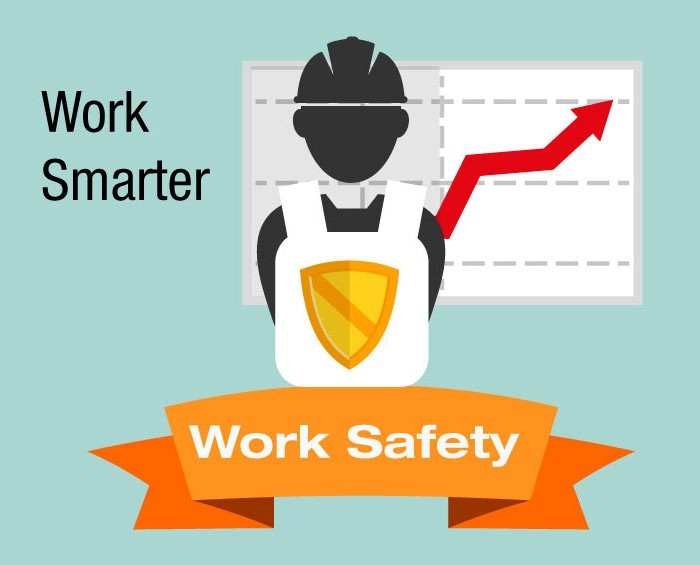Working Safer is Working Smarter
- Human Resources
- Article
-
6 min. Read
-
Last Updated: 06/30/2015

Table of Contents
Paychex safety experts give tips to protect your workforce, comply with OSHA
“Safety costs money, but it saves money,” says Jim Bartasevich, a safety and loss control consultant with Paychex. “Fines, injuries on the job, workers’ compensation insurance, interruptions to the product, damage to the product —these are hidden costs that employers have to absorb. If they have to pay more for workers’ compensation [insurance] because they have a poor accident record, they’re going to have to charge more for their business or products or services.”
Bartasevich and two of his Paychex safety-consultant colleagues, Donna Mandell and Greg Murano, together offer more than 100 years of experience with industries of every description. They help Paychex clients develop, implement and improve safety programs, and instruct employers in the compliance requirements of the Occupational Safety and Health Administration (OSHA). Tapping the trio’s collective wisdom yields insights that employers can use to create safer work environments.
Every business needs a safety program
“A lot of small businesses don’t believe they need a safety program,” Murano says. “You have to convince them, even if it’s a one-person company. If that one person gets hurt and he or she goes to the hospital, and it’s serious, the hospital has an obligation to call OSHA, and OSHA will show up on your doorstep. A good safety program will protect employees from getting injured and save a company money in the long run.”
Per OSHA, “Every company has got to have an emergency plan,” says Mandell. It’s essential that people react appropriately in case of fire, a tornado, toxic gas release, earthquake and other natural and manmade crises. But too often, they don’t know how, she says. “An alarm goes off and sometimes everyone sits there and looks at one another. They wonder, ‘Is that real?’ It takes a few minutes before you realize that it’s an emergency. People sometimes react like lemmings —they will tend to follow one person. And if that person happens to go in the wrong direction, you may end up with a big problem!”
In addition to an emergency action plan, Mandell says, are safety programs that may also be specific to certain industries and work sites. Examples are hazard communications for those that handle or can get exposed to any chemicals, fall-prevention requirements that are very typical activities at construction sites, and steps to prevent exposure to blood-borne pathogens in healthcare settings. Even office environments post some risks, she notes. When people work at computers all day, “Back safety and ergonomics is very important. The most common injury for office workers is carpal tunnel syndrome. Being hunched over a computer, the repetitiveness of typing at a computer, and sometimes sitting for long periods of time or in awkward positions can cause injury.”
Companies also report about 400 deaths from cardiac arrest to OSHA each year. So, although the agency does not mandate an automatic external defibrillator (AED), it recommends that every workplace keep one on hand in case someone suffers cardiac arrest. These easy-to-use devices can restart a stopped heart, saving a life. It’s good to know ahead of time whether someone in the building is trained to respond, or whether the company relies on first responders.
One highly valued service Paychex safety consultants provide is condensing the information in the OSHA safety manual to make it digestible, less daunting. “We provide a road map for your safety program,” Mandell says. “We’ll help get them started, and we will follow up with you. You’re not [doing it] alone. Their fears are relaxed, they feel more at ease…” Paychex also assists clients with the required OSHA documentation.
Get people involved, invested in a safety program
Safe companies embed safety into their corporate cultures. Everyone—from the CEO to the cleaning staff—should buy into the safety mindset. “Once you can get safety integrated into day-to-day business, it becomes second nature,” Mandell says.
She employs a “Stoplight Safety” program with her clients, incentivizing a workforce using competition and nonmonetary rewards. “You can set it up different ways—by departments, by locations,” she says. “Maintain safety criteria that are visible, things that can be accounted for.” Say a machine is running all the time, and all employees wear protective equipment when they’re near it: “They get a green light,” Mandell says. “If somebody has a near miss or a Band-Aid accident, they get a yellow. A serious accident flags the department with a red light. It takes a predetermined amount of time to get that green light back.” Sections that maintain a green light for certain intervals celebrate the milestones with pizza parties or other group events, reinforcing safe conduct.
“Customize your safety competitions, come up with your own criteria,” Mandell urges. Everyone likes to compete a little bit. Use internal competition to create the behaviors of a safety culture. It’s how you eat an elephant: One bite at a time.”
Murano suggests keeping safety information in front of employees as much as possible. Visibility—and visual aids—are important, he says. Put up a bulletin board with topics of importance and pictorial instructions for safe procedures. Include monthly tips with employee paychecks. “Safety isn’t only at work, it’s also at home,” he says. “For example, give staff reminders to change smoke alarm batteries, have a home fire-escape plan, change the CO2 cartridges in fire extinguishers.”
Murano notes that a “good ol’ boy mentality” in some industries hinders a safety culture. Longtime workers in a factory, say, may view losing a finger in a machine as part of the job: a badge of experience. “It’s important to get rid of that philosophy. Someone may say, ‘I’ve been in business 40 years, nothing’s ever going to happen.’ But you have one serious incident, or someone dies, and your comp insurance goes up: How do you make up that money? It [can] take almost 10 years to make up a $5,000 OSHA fine. You have to convince them a safety program will work.”
Risks lurk where you least expect them
In addition to teaching clients how to use their OSHA safety manual, Paychex safety consultants earn gratitude by pointing out unrecognized hazards. Murano says people are nearly always surprised when he tells them that power strips—ubiquitous in office settings—should be at least a foot off the floor. Almost always, these devices are under desks or other furniture. “Why, by building code, are wall outlets one foot off the floor?” Murano asks. “Water. Surge protectors are also supposed to be a foot off the floor.” Both OSHA officers and building inspectors will call employers on this safety hazard.
When clients don’t have the time to schedule on-site visits from Paychex safety consultants, a virtual “walk-through” via a tablet computer or smart phone or by sending digital photos can prove just as effective. From these videos, “You’ll see things [clients] have been looking at for 20 years and didn’t see as a safety problem,” Murano says. For example, blocked fire extinguishers, electrical wires dangling from the ceiling, machinery lacking safety guards. “These sorts of things wouldn’t come up in a phone call about workplace safety.”
Once they’ve analyzed a worksite and its hazards, Paychex safety consultants list their findings and offer remedies. Presenting pictures of fixes—the right way to do things—is very helpful, Murano says. “I want people to swim, not sink, so I don’t just tell them what’s wrong: I show them how to fix their issues.”
Fear of OSHA
Many employers fear an unexpected visit from an OSHA inspector: The agency generally conducts inspections without advance notice. Because OSHA cannot inspect all 7 million U.S. businesses under its jurisdiction each year, it spotlights certain industries. “OSHA has about 2,000 compliance officers for the whole country, so they have to prioritize what they do,” Bartasevich says. “They’re not going to spend a lot of time in offices. They’re going to go to construction companies, factories, chemical companies, places where historically people have died or been injured.”
OSHA uses a six-tier priority list for inspections:
- Imminent danger situations— hazards that could cause death or serious physical harm
- Fatalities and catastrophes— incidents that involve a death or the hospitalization of three or more employees
- Complaints—allegations of hazards or violations
- Referrals of hazard information from other federal, state or local agencies, individuals, organizations or the media
- Follow-ups— checks for abatement of violations cited during previous inspections
- Planned or programmed investigations—inspections aimed at specific high-hazard industries or individual workplaces that have experienced high rates of injuries and illnesses—also receive priority
OSHA annually publishes a list of the most frequently cited standards. This list can guide some businesses in safety training.
Bartasevich says a valuable component of Paychex safety consultations is teaching employers what to expect during an OSHA inspection. “There’s a procedure inspectors have to follow. They have to tell you why they’re there and what they’re going to do and what info they want.” Forewarned is forearmed, especially when it comes to OSHA inspections.
When that OSHA inspector walks in, employers may worry: “What are they going to find? They’re going to fine me! I’ve got to get that safety program up and running …. I should have done it yesterday,” says Mandell. “They feel overwhelmed. When they see the [safety] program [for their industry] they feel like they have a mountain sitting in front of them. Our job is to make it easier for them to get compliant, hold their hand, walk ’em through the process if they need it. Some clients want the hand-holding; others say, ‘I’m good, I’ll call you when I have a question.’ You give the client what they want.”
Safety lacks glamour, but not necessity
“It’s tough to get excited about safety because it’s a very dry subject,” Mandell says ruefully. “We all know that, because we’ve been on the other side. We’ve had to be the doers; now we’re the consultants. That kind of expertise is very valuable to clients.”
Paychex safety consultants develop client-specific safety plans based on “the type of business the equipment used, and the activities of employees,” Murano notes. “Our plans are based on OSHA or state compliance and best practices in particular industries. And common sense.”
Bartasevich points out that Paychex provides safety consultations in person or via recorded, online presentations. Virtual training is a popular option for many busy companies. “We send them the link to the Paychex training website, which clients can access 24/7; they see all the safety programs they can join” and can take the training on their own schedule.
He reiterates: “Safety costs money, but it saves money.” Murano adds, “[A safety program] takes some effort, but it will work in the long run. People will come to work in a safe environment, people will be happy to work there, and in long run you will save money.”
Tags







